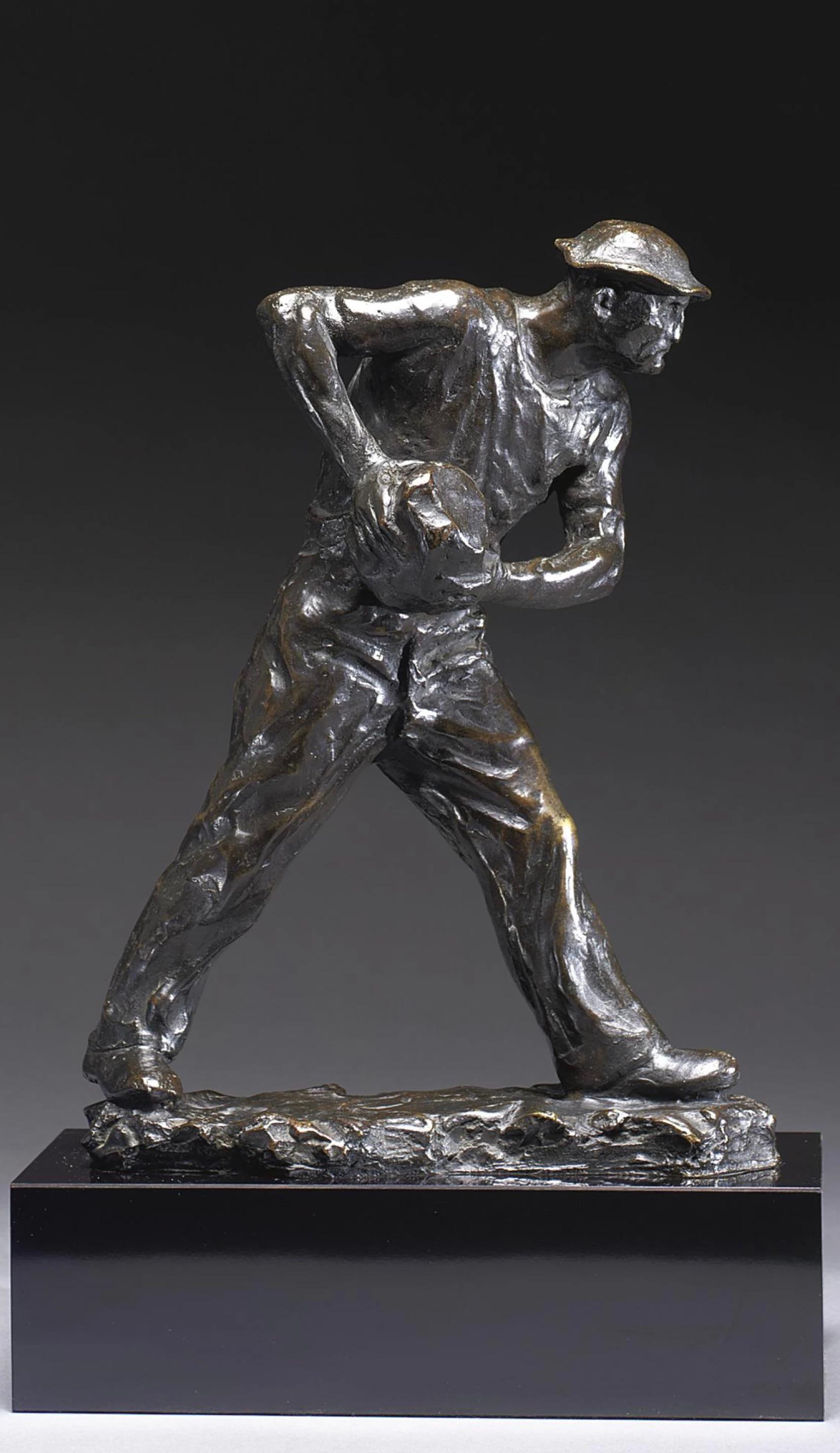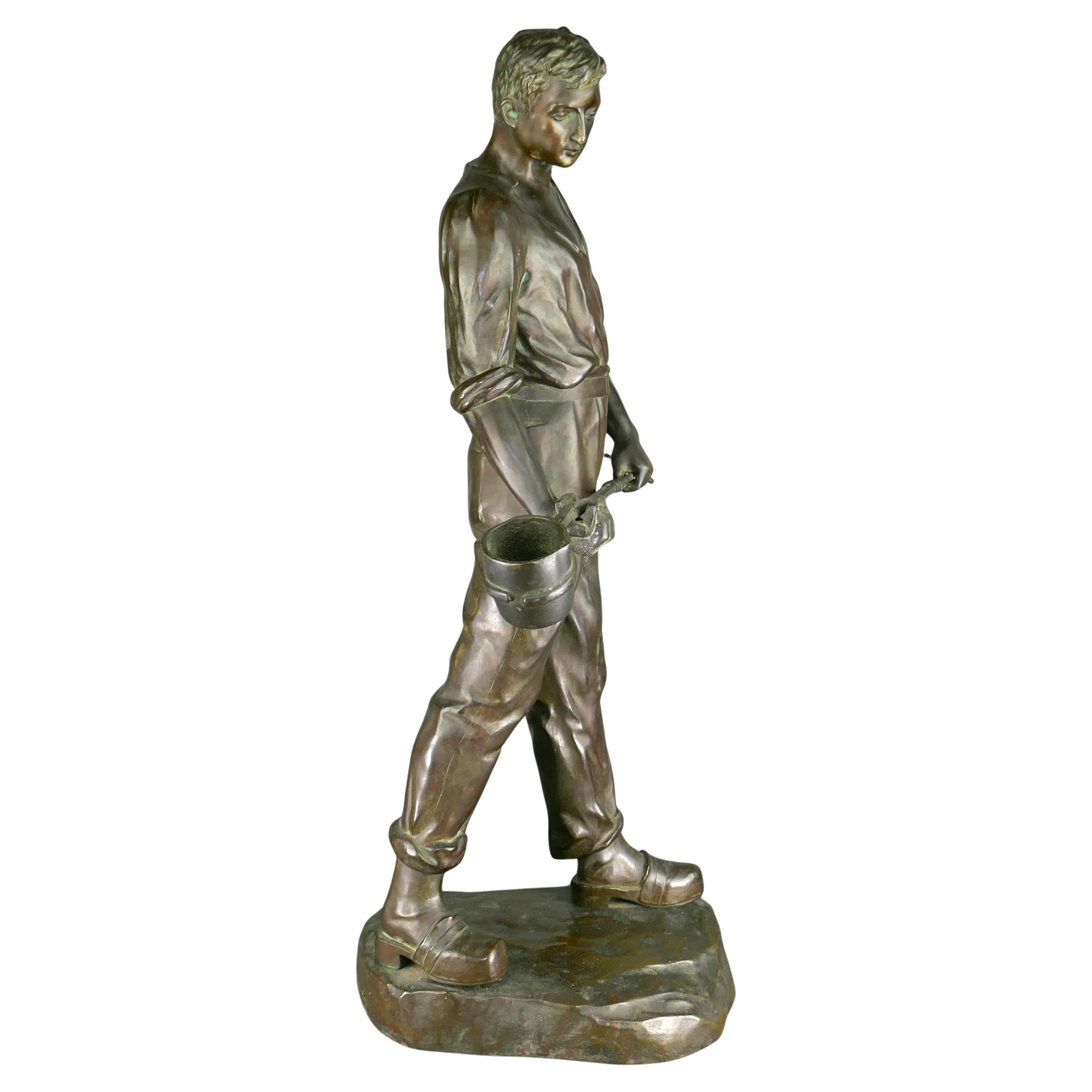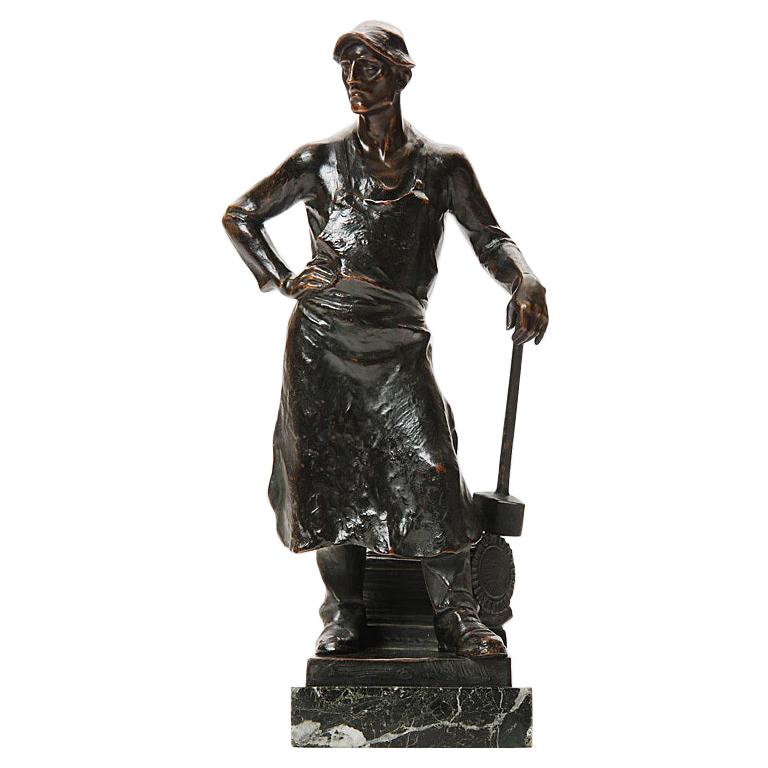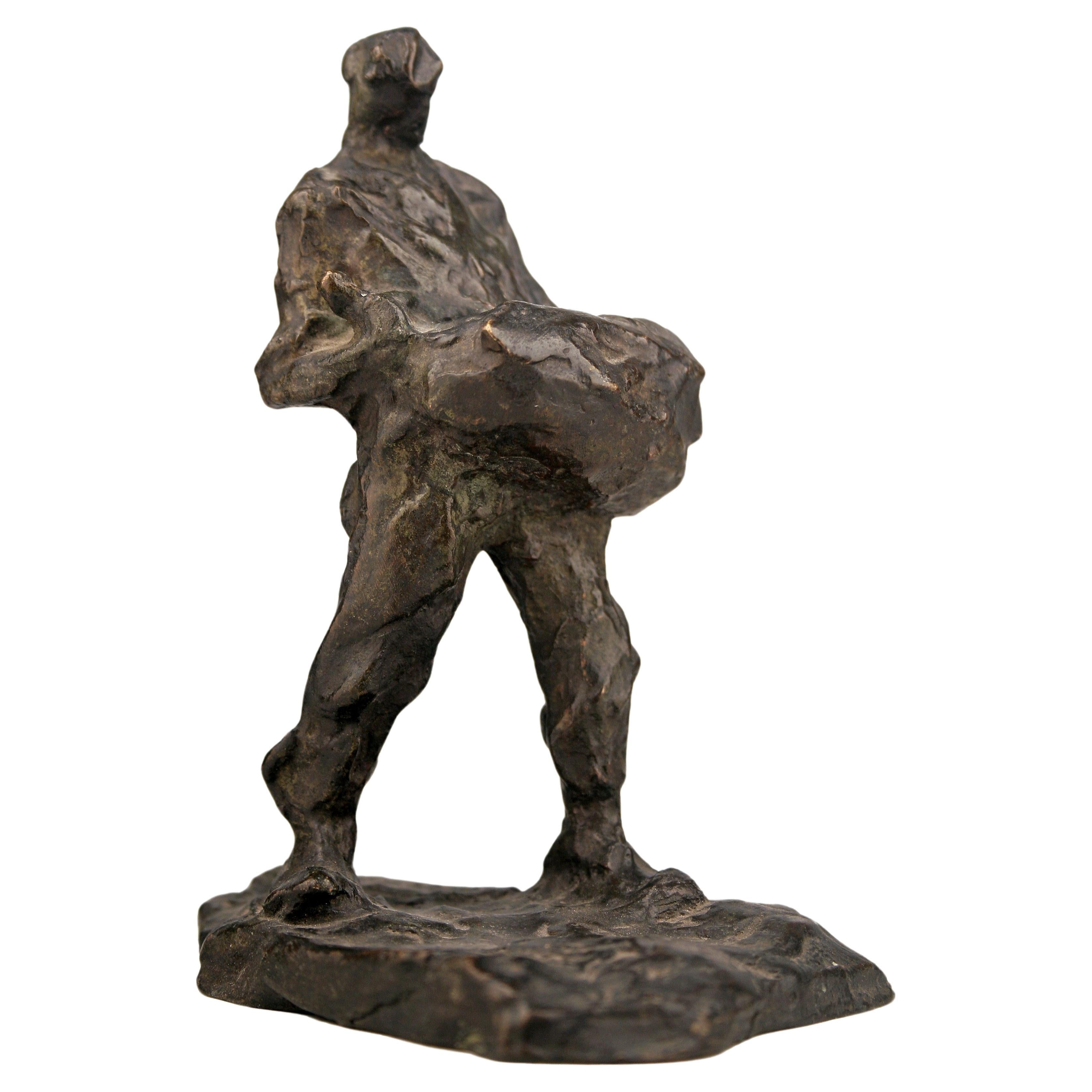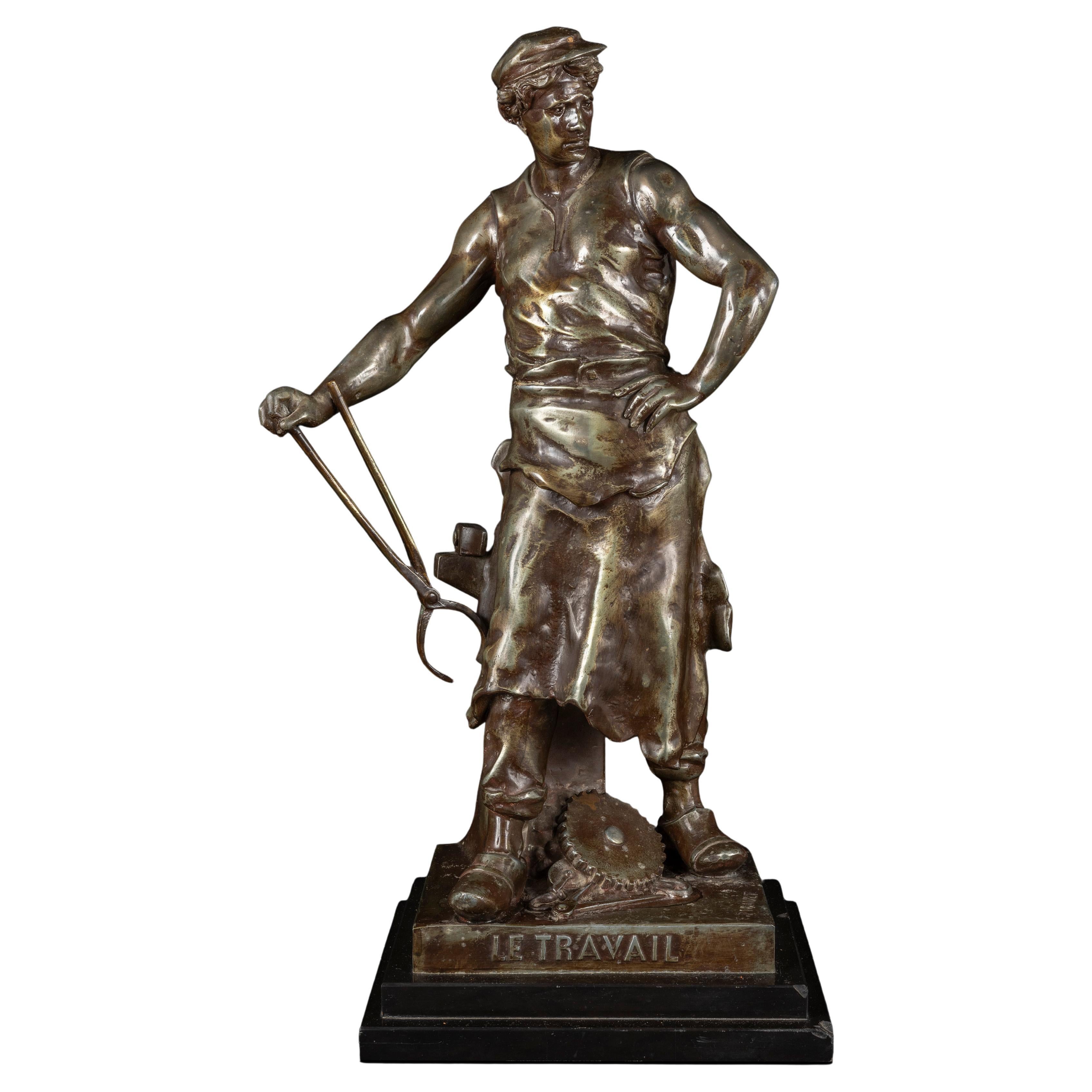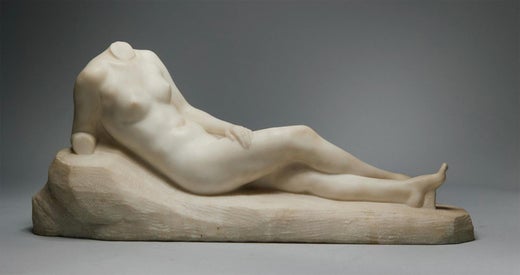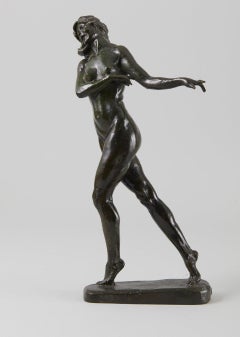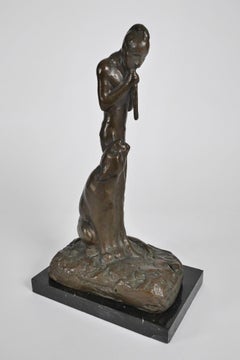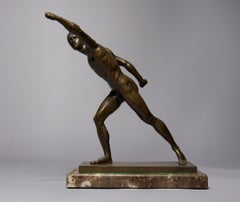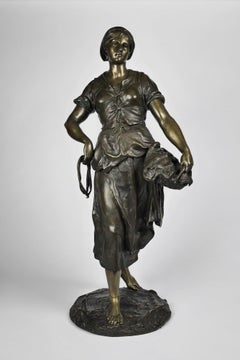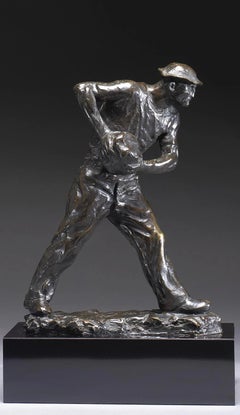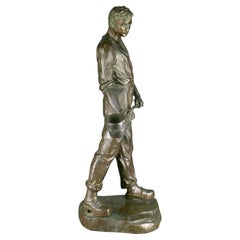Items Similar to Locomotive Engineer, Early 20th Century Bronze Laborer, Cleveland School
Video Loading
Want more images or videos?
Request additional images or videos from the seller
1 of 14
Max KalishLocomotive Engineer, Early 20th Century Bronze Laborer, Cleveland School1926
1926
$40,500
£30,588.69
€35,351.49
CA$56,807.45
A$63,175.38
CHF 33,069.40
MX$770,662.84
NOK 415,529.03
SEK 390,858.70
DKK 263,875.89
About the Item
Max Kalish (American, 1891-1945)
Locomotive Engineer, 1926
Bronze
Signed and dated on base, foundry mark: Meroni Radice Cire Perdue Paris
15.5 x 6 x 5 inches
Born in Poland March 1, 1891, figurative sculptor Max Kalish came to the United States in 1894, his family settling in Ohio. A talented youth, Kalish enrolled at the Cleveland Institute of Art as a fifteen-year-old, receiving a first-place award for modeling the figure during studies with Herman Matzen. Kalish went to New York City following graduation, studying with Isidore Konti and Herbert Adams for the next two years.
In 1912, Kalish studied with Paul Bartlett at the Academie Colarossi in Paris, France. In 1913, he continued his studies with Jean Antoine Injalbert at the Ecole des Beaux-Arts. The financial support of his brother, family and friends had enabled Kalish to travel to Europe. But the money ran out and, though Kalish exhibited two portrait busts in the 1913 Paris Salon, he was forced to return to America, where he worked on the Column of Progress for the 1915 Panama-Pacific Exposition, in San Francisco, California, with his former teacher, Isidore Konti.
Back in Cleveland, he worked on portrait commissions of two United States Senators and the Mayor. In the Army by 1916, Kalish sculpted a series of bronze, one-third-life-size figures of solders. In 1920, he was back in Paris, where he would begin a life-long practice of spending half the year. In 1921, he sculpted his first laborer, “The Stoker”, a genre for which he would be best known, using as a model, a Cleveland blast furnace worker. In Paris in 1922, the sculptures of laborers by Belgian artist Constantine Meunier (1831-1905) cemented Kalish’s desire to sculpt workers. Kalish won first prize for four sculptures three laborers — in 1925 at the Cleveland Artists and Craftsmen exhibition, one of which a marble nude torso was acquired by the Cleveland Museum of Art. This prize and purchase accelerated Kalish’s career. In 1928, he received a commission from the City of Cleveland for a twelve-foot-high bronze sculpture of Abraham Lincoln delivering the Gettysburg Address. It stands today in front of the west entrance of the Board of Education on East 6th Street.
Living and working in New York City in 1932, he was elected an Associate of the National Academy of Design in 1933. He later became a member of the National Sculpture Society. At the outset of World War II, Kalish was commissioned by the Museum of American History to sculpt forty-eight bronze figures — one-third-life-size — of those involved in the war effort, including President Roosevelt, his cabinet and other important people. He lived to see the work completed, though afflicted by cancer from which he died on March 18, 1945 in New York City. The sculpture of Max Kalish was included in the 1997 exhibition in Berkeley, California, “When Artists Became Workers: The People’s Art Movement of the ’30s and ’40s”, at the Judah L. Magnes Museum.
Books about the life and work of Max Kalish include Lawson Lewis’s 1933, The Sculpture of Max Kalish; the 1938 publication, Labor Sculpture by Max Kalish; James Mackay’s, 1977, Dictionary of Sculptors in Bronze; Glenn Opitz’s, 1984, Dictionary of American Sculptors; and Rediscoveries in American Sculpture by Janis Conner & Joel Rosenkranz, 1989.
- Creator:Max Kalish (1891 - 1945, American, Lithuanian)
- Creation Year:1926
- Dimensions:Height: 15.5 in (39.37 cm)Width: 6 in (15.24 cm)Depth: 5 in (12.7 cm)
- Medium:
- Period:
- Condition:
- Gallery Location:Beachwood, OH
- Reference Number:1stDibs: LU1768215621432
Max Kalish
Born in Poland March 1, 1891, figurative sculptor Max Kalish came to the United States in 1894, his family settling in Ohio. A talented youth, Kalish enrolled at the Cleveland Institute of Art as a fifteen-year-old, receiving a first-place award for modeling the figure during studies with Herman Matzen. Kalish went to New York City following graduation, studying with Isidore Konti and Herbert Adams for the next two years. In 1912, Kalish studied with Paul Bartlett at the Academie Colarossi in Paris, France. In 1913, he continued his studies with Jean Antoine Injalbert at the Ecole des Beaux-Arts. The financial support of his brother, family and friends had enabled Kalish to travel to Europe. But the money ran out and, though Kalish exhibited two portrait busts in the 1913 Paris Salon, he was forced to return to America, where he worked on the Column of Progress for the 1915 Panama-Pacific Exposition, in San Francisco, California, with his former teacher, Isidore Konti. Back in Cleveland, he worked on portrait commissions of two United States Senators and the Mayor. In the Army by 1916, Kalish sculpted a series of bronze, one-third-life-size figures of solders. In 1920, he was back in Paris, where he would begin a life-long practice of spending half the year. In 1921, he sculpted his first laborer, “The Stoker”, a genre for which he would be best known, using as a model, a Cleveland blast furnace worker. In Paris in 1922, the sculptures of laborers by Belgian artist Constantine Meunier (1831-1905) cemented Kalish’s desire to sculpt workers. Kalish won first prize for four sculptures three laborers — in 1925 at the Cleveland Artists and Craftsmen exhibition, one of which a marble nude torso was acquired by the Cleveland Museum of Art. This prize and purchase accelerated Kalish’s career. In 1928, he received a commission from the City of Cleveland for a twelve-foot-high bronze sculpture of Abraham Lincoln delivering the Gettysburg Address. It stands today in front of the west entrance of the Board of Education on East 6th Street. Living and working in New York City in 1932, he was elected an Associate of the National Academy of Design in 1933. He later became a member of the National Sculpture Society. At the outset of World War II, Kalish was commissioned by the Museum of American History to sculpt forty-eight bronze figures — one-third-life-size — of those involved in the war effort, including President Roosevelt, his cabinet and other important people. He lived to see the work completed, though afflicted by cancer from which he died on March 18, 1945 in New York City. The sculpture of Max Kalish was included in the 1997 exhibition in Berkeley, California, “When Artists Became Workers: The People’s Art Movement of the ’30s and ’40s”, at the Judah L. Magnes Museum.
About the Seller
5.0
Platinum Seller
Premium sellers with a 4.7+ rating and 24-hour response times
Established in 1975
1stDibs seller since 2022
37 sales on 1stDibs
Typical response time: <1 hour
- ShippingRetrieving quote...Shipping from: Beachwood, OH
- Return Policy
Authenticity Guarantee
In the unlikely event there’s an issue with an item’s authenticity, contact us within 1 year for a full refund. DetailsMoney-Back Guarantee
If your item is not as described, is damaged in transit, or does not arrive, contact us within 7 days for a full refund. Details24-Hour Cancellation
You have a 24-hour grace period in which to reconsider your purchase, with no questions asked.Vetted Professional Sellers
Our world-class sellers must adhere to strict standards for service and quality, maintaining the integrity of our listings.Price-Match Guarantee
If you find that a seller listed the same item for a lower price elsewhere, we’ll match it.Trusted Global Delivery
Our best-in-class carrier network provides specialized shipping options worldwide, including custom delivery.More From This Seller
View AllNude Walking, Early 20th Century Bronze Sculpture, Cleveland School Artist
By Max Kalish
Located in Beachwood, OH
Max Kalish (American, 1891-1945)
Nude Walking, 1930
Bronze
Signed and dated on base
17 x 9 x 4 inches
Born in Poland March 1, 1891, figurative sculptor Max Kalish came to the United States in 1894, his family settling in Ohio. A talented youth, Kalish enrolled at the Cleveland Institute of Art as a fifteen-year-old, receiving a first-place award for modeling the figure during studies with Herman Matzen. Kalish went to New York City following graduation, studying with Isidore Konti and Herbert Adams...
Category
1930s American Modern Figurative Sculptures
Materials
Bronze
Man with Flute and Cougar, American 19th/20th century bronze w/ marble base
By Edwin Willard Deming
Located in Beachwood, OH
Edwin Willard Deming (American, 1860-1942)
Man with Flute and Cougar
Cast bronze sculpture with golden brown patina
Signed, numbered 9/100, with Fenn F...
Category
Late 19th Century Figurative Sculptures
Materials
Marble, Bronze
19th Century Bronze of the Borghese Gladiator Sculpture
Located in Beachwood, OH
The Borghese Gladiator, 19th Century
Bronze on marble base
Musée du Louvre signed on base
15 x 12 x 8 inches
Since its discovery in the early seventeenth century, the Borghese Gladi...
Category
19th Century Figurative Sculptures
Materials
Marble, Bronze
The Fisherwoman, 19th century French bronze sculpture
By Émile Louis Picault
Located in Beachwood, OH
Émile Louis Picault (French, 1833-1915)
Fisherwoman
Bronze
Stamped "E. Picault"
30 x 15 x 12 inches
Subject depicting a young woman holding fishing line in one hand a basket of fis...
Category
19th Century Figurative Sculptures
Materials
Bronze
Muse of Dance, Early 20th century French bronze sculpture of woman
Located in Beachwood, OH
Louis Armand Bardery (French, 1879-1952)
Muse of Dance
Bronze with green and brown patination
Signed and stamped with foundry mark
18 x 6 inches
Louis Armand Bardery was a student o...
Category
Early 20th Century Figurative Sculptures
Materials
Bronze
Grand Tour Bronze Sculpture of Dionysus, 19th Century Italian School
Located in Beachwood, OH
19th Century Italian School
Grand Tour Bronze Sculpture of Dionysus, 19th Century
Bronze with black-green patination
24 x 10 x 10 inches
Dionysus, in Greco-Roman religion, a nature ...
Category
19th Century Italian School Figurative Sculptures
Materials
Bronze
You May Also Like
"Road Builder" 20th Century Modern WPA Labor Bronze WPA Depression-Era Sculpture
By Max Kalish
Located in New York, NY
Max Kalish
The Road Builder
inscribed M. KALISH 23, with Meroni-Radice foundry mark, on top of base bronze with dark brown patina, on an ebonized rectangular plinth
Height: 13 1/8 in. not including base
Provenance: Spanierman Gallery, New York
BIO
Max Kalish (1891 – 1945)
Born in Poland March 1, 1891, figurative sculptor Max Kalish came to the United States in 1894, his family settling in Ohio. A talented youth, Kalish enrolled at the Cleveland Institute of Art as a fifteen-year-old, receiving a first-place award for modeling the figure during studies with Herman Matzen. Kalish went to New York City following graduation, studying with Isidore Konti and Herbert Adams...
Category
1920s American Realist Figurative Sculptures
Materials
Bronze
German Bauhaus Wiener Werkstatte B. Grundmann Bronze Statue of a Male Smelter
By Wiener Werkstätte
Located in San Juan Capistrano, CA
Striking German Bauhaus Art Deco Cast Bronze Sculpture of a Young Male Smelter by Bernard Grundmann. The piece was produced at the Berlin Wiener Werkstatte studio in 1929-30 and sign...
Category
Early 20th Century German Art Deco Figurative Sculptures
Materials
Bronze
Construction & Garment Worker, WPA Bronze by Robert Cronbach
By Robert Cronbach
Located in Long Island City, NY
Artist: Robert Cronbach, American (1908 - 2001)
Title: Construction & Garment Worker
Year: 1938
Medium: Bronze sculpture with Brown Patina, signature and date in the cast
Size: 18 ...
Category
1930s American Modern Figurative Sculptures
Materials
Bronze
Sculpture of Standing Blacksmith by Adolf Joseph Phol
By Adolph Joseph Pohl 1
Located in Sagaponack, NY
A bronze statue of a blacksmith on a marble base by Adolph Joseph Pohl. Made in Austria, circa 1920s.
Category
Early 20th Century Austrian Vienna Secession Sculptures
Materials
Marble, Bronze
Early 20th Century Bronze Sculpture of Carrying Man by Belgian Sculptor Demanet
By Victor Demanet
Located in North Miami, FL
Early 20th century patinated bronze sculpture of carrying man by belgian sculptor Victor Demanet and BL Paris
By: Victor Demanet, BL Paris
Material: bronze, copper, metal
Technique:...
Category
Early 20th Century French Expressionist Figurative Sculptures
Materials
Bronze, Metal, Copper
Emile Louis Picault (1833-1915) « LE TRAVAIL » bronze statue
By Émile Louis Picault
Located in Ixelles, BE
Emile Louis Picault (1833-1915) « LE TRAVAIL » bronze statue
The bronze statue 'Le Travail' by Émile Louis Picault is much more than a mere work of art. It embodies the very essence...
Category
Antique 19th Century French Industrial Figurative Sculptures
Materials
Bronze
More Ways To Browse
Max Bronze
Antique Bronze Marks
L Art France Bronze
Salon Des Beaux Arts Bronze
Herman Gold
Sculptors Modeling Stand
Antique Bronze Foundry Marks
Worker Bronze
Antique French Dictionary
6 Foot Sculpture
Antique Furnaces
Antique American History Books
Torso Bust Sculpture
Marble Bust Mark
Antique Marble Torso
Antique Locomotives
Dictionary Stand Antique
Constantine Sculpture
